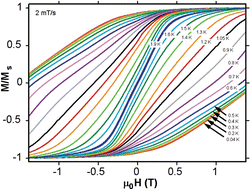Constructing clusters with enhanced magnetic properties by assembling and distorting Mn3 building blocks†
Abstract
The reaction of Mn(ClO4)2·6H2O with Naphth-saoH2 (Naphth-saoH2 = 2-hydroxy-1-napthaldoxime) in

* Corresponding authors
a
Department of Chemistry, University of Crete, Herakleion, Greece
E-mail:
komil@chemistry.uoc.gr
Tel: +30-2810-545099
b
School of Chemistry, The University of Edinburgh, West Mains Road, UK
E-mail:
ebrechin@staffmail.ed.ac.uk
Tel: +44-131-6507545
c Institut Néel, CNRS & Université J. Fourier, BP 166, France
The reaction of Mn(ClO4)2·6H2O with Naphth-saoH2 (Naphth-saoH2 = 2-hydroxy-1-napthaldoxime) in

 Please wait while we load your content...
Something went wrong. Try again?
Please wait while we load your content...
Something went wrong. Try again?
C. J. Milios, R. Inglis, L. F. Jones, A. Prescimone, S. Parsons, W. Wernsdorfer and E. K. Brechin, Dalton Trans., 2009, 2812 DOI: 10.1039/B820362H
To request permission to reproduce material from this article, please go to the Copyright Clearance Center request page.
If you are an author contributing to an RSC publication, you do not need to request permission provided correct acknowledgement is given.
If you are the author of this article, you do not need to request permission to reproduce figures and diagrams provided correct acknowledgement is given. If you want to reproduce the whole article in a third-party publication (excluding your thesis/dissertation for which permission is not required) please go to the Copyright Clearance Center request page.
Read more about how to correctly acknowledge RSC content.
 Fetching data from CrossRef.
Fetching data from CrossRef.
This may take some time to load.
Loading related content
